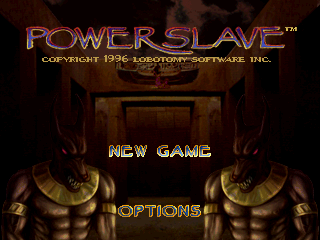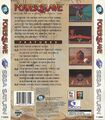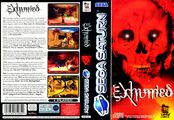Difference between revisions of "Powerslave"
From Sega Retro
m |
|||
| Line 75: | Line 75: | ||
| joypad_source={{num|57|page=98/99}} | | joypad_source={{num|57|page=98/99}} | ||
| mms=94 | | mms=94 | ||
| − | | mms_source={{num|47|page=52 | + | | mms_source={{num|47|page=52-54|pdf=MeanMachinesSega47UK.pdf|pdfpage=52}} |
| playerone=89 | | playerone=89 | ||
| playerone_source={{num|68|page=92/93}} | | playerone_source={{num|68|page=92/93}} | ||
Revision as of 19:23, 15 December 2014
| Powerslave | |||||
|---|---|---|---|---|---|
| System(s): Sega Saturn | |||||
| Publisher: BMG Interactive, Playmates Interactive Entertainment (US) | |||||
| Developer: Lobotomy Software | |||||
| Genre: Action | |||||
| Number of players: 1 (2-6 for Death Tank) | |||||
| |||||
This teeny-tiny article needs some work. You can help us by expanding it.
Powerslave, known as Exhumed in Europe and Seireki 1999: Pharaoh no Fukkatsu (西暦1999 ファラオの復活) in Japan, is a first person shooter game developed by Lobotomy Software. It was ported to the Sega Saturn in 1996.
Contents
Slave Driver Game Engine
The original version appeared on the PC as a Build engine game and featured many mechanics, levels and content that varied differently. This includes linear level design, in-game speech from the main character, and stock lives that once they've run out, the game ends for the player. When the game was brought to the Sega Saturn and PlayStation, the game was rebuilt from the ground up using a proprietary engine called Slave Driver which was able to render more complex levels, including rooms above other rooms, which was not possible on the Build engine. It also went through a major gameplay re-design thanks to the stronger hardware. The Slave Driver engine would become a framework for PC to console ports by Lobotomy Software including Duke Nukem 3D and Quake.
Extra Feature
Death Tank
US version of Powerslave contains a mini game called Death Tank that can be accessed if you collect all 23 dolls hidden in the game. The mini-game supports up to 6 players, which was increased up to 7 players in it's sequel, Death Tank Zwei, which can be found in Duke Nukem 3D.
Saving Data
Powerslave makes use of the Saturn's internal battery back-up as well as the Saturn Backup Memory to save data for progress. To load and save data from the Ram Cart, the save file must be created on the internal battery back-up first, then moved over via the Memory Manager.
| Name | Comment | File Size |
|---|---|---|
| POWERSLAVE# | save games | 11 |
Production Credits
Executive Producers: Brian McNeely, Paul Lange
Game Design: Brian McNeely
Additional Game Design: Dominick Meissner, Mark Coates, Jason Wiggin, Ezra Dreisbach
Game Programming: Ezra Dreisbach
BREW World Editing Tool: David Lawson
Art and Environment: Troy Jacobson, Brian McNeely, John Van Deusen, Kevin Chung, Paul Knutzen, Richard Nichols, Eric Klokstad, Joe Kfesoja, Jason Wiggin, Willian Vallieres
Creatures and Weaponry: John Van Deusen
Music and Sound Effects: Scott Branston
Stage Design: Brian McNeely, Domick Meissner, Paul Knutzen, Jason Wiggin, Mark Coates
Additional Technical Support: Jeff Blazier, John Schwab, John Yuill, Paul Magefud, Paul Schreiber, Pat Schreiber, Kurt Pfeifer
Instruction Manual: Tom Kristensen
Special THANKS! To: Jacqui Lyons, Marjacq Micro, Ian Mathias, Mike Brown, Ronya, Lonnie, Nasie, and of Course Sega
Promotional Material
- PowerSlave Saturn US PrintAdvert.jpg
US print advert
Physical Scans
| 85 | |
|---|---|
| Based on 34 reviews | |
- ↑ 1.0 1.1 File:MeanMachinesSega47UK.pdf, page 52 Cite error: Invalid
<ref>tag; name ":File:MeanMachinesSega47UK.pdf_p52" defined multiple times with different content - ↑ 576 KByte, "Október 1996" (HU; 1996-xx-xx), page 26
- ↑ Computer & Video Games, "September 1996" (UK; 1996-08-11), page 72
- ↑ Electronic Gaming Monthly, "December 1996" (US; 1996-xx-xx), page 85
- ↑ Famitsu, "1996-12-06" (JP; 1996-11-22), page 1
- ↑ Freak, "3/97" (IL; 1997-xx-xx), page 1
- ↑ Fun Generation, "11/96" (DE; 1996-10-09), page 78
- ↑ Gambler, "4/1997" (PL; 1997-xx-xx), page 1
- ↑ GameFan, "Volume 4, Issue 11: November 1996" (US; 1996-xx-xx), page 18
- ↑ GamePro, "November 1996" (US; 1996-xx-xx), page 120
- ↑ GamesMaster, "September 1996" (UK; 1996-08-01), page 51
- ↑ Game Informer, "December 1996" (US; 1996-1x-xx), page 65
- ↑ Gry Komputerowe, "1-2/1997" (PL; 1997-xx-xx), page 1
- ↑ Hobby Consolas, "Octubre 1996" (ES; 1996-xx-xx), page 68
- ↑ Joypad, "Octobre 1996" (FR; 1996-xx-xx), page 98
- ↑ LeveL, "Prosinec 1996" (CZ; 1996-12-01), page 82
- ↑ MAN!AC, "11/96" (DE; 1996-10-09), page 74
- ↑ Mega Force, "Novembre/Décembre 1996" (FR; 1996-1x-xx), page 36
- ↑ Mega Fun, "10/96" (DE; 1996-09-18), page 60
- ↑ Player One, "Octobre 1996" (FR; 1996-xx-xx), page 92
- ↑ Saturn Fan, "1996 No. 24" (JP; 1996-11-15), page 188
- ↑ Saturn Fan, "1997 No. 2" (JP; 1997-01-17), page 70
- ↑ Saturn+, "Issue 4" (UK; 1996-10-24), page 28
- ↑ Score, "Prosinec 1996" (CZ; 1996-12-01), page 112
- ↑ Secret Service, "Marzec 1997" (PL; 1997-xx-xx), page 67
- ↑ Sega News, "Listopad 1996" (CZ; 1996-1x-xx), page 10
- ↑ Sega Power, "September 1996" (UK; 1996-08-01), page 34
- ↑ Świat Gier Komputerowych, "2/1997" (PL; 1997-xx-xx), page 1
- ↑ Sega Saturn Magazine, "September 1996" (UK; 1996-08-20), page 68
- ↑ Sega Saturn Magazine, "1996-21 (1996-12-13)" (JP; 1996-11-22), page 269
- ↑ Sega Saturn Magazine, "Readers rating final data" (JP; 2000-03), page 11
- ↑ Total Saturn, "Volume One Issue Two" (UK; 1996-09-30), page 58
- ↑ Total Saturn, "Volume One Issue Four" (UK; 1996-12-29), page 25
- ↑ Video Games, "10/96" (DE; 1996-09-25), page 86
- Pages with broken file links
- Pages with reference errors
- 2 player games
- 1 player games
- Old content rating field
- Use romtable template
- All games
- Sub-stubs
- Old-style rating (cvg)
- Rating without PDF source
- Old-style rating (joypad)
- Old-style rating (mms)
- Use magref
- Old-style rating (playerone)
- Old-style rating (segapower)
- Old-style rating (ssm)
- Update ratings template
- 6 old ratings





